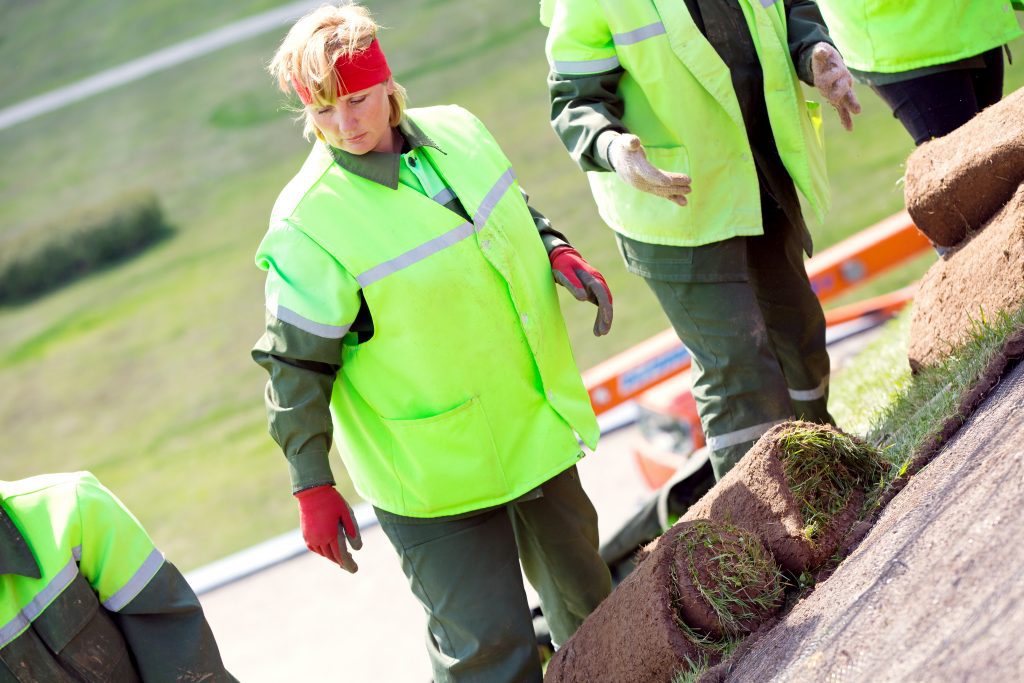Learn the Important Difference Between Formal and On-The-Job Training

When it comes to training new and existing landscaping employees, there are two schools of thought: on-the-job (sometimes called OJT) and formal training. Both have their advantages and disadvantages, but only you can know which style of training is best for your business. We break down some of the most important differences between OJT and formal training below.
Formal training
It’s quite likely that you’re already familiar with formal training. It’s the kind of training that they use in schools, most often referred to as “teaching.” Formal training is often delivered by someone trained to teach, and the learning objectives are defined by a training organization, department, or individual instructor. Generally, formal training involves a lecture or class where information is shared, and trainees (or students) validate what they have been taught through testing.
Some advantages of formal training are:
Training is consistent. Because there is a consistent syllabus or objective, training is the same for each person.
Training is measurable. Since formal training relies on testing, you can easily understand who is or isn’t up to speed.
Compared to on-the-job training, formal training is normally more time consuming and is often more expensive than OJT. But that’s not always the case.
In the past few years, online training programs like Udemy and Linda.com have reduced both the time and cost that are normally associated with a quality formal education. Delivered online through modules or videos, these training platforms allow people to learn almost anything they want at a fraction of the cost and time of regular formal training. With online formal training, you can very quickly and efficiently get yourself or your employees trained and up to speed.
On-The-Job training
On-the-job training is probably the most popular form of training in the landscaping industry. OJT is training that is delivered while an employee is performing tasks related to their particular job. It’s a “hands-on” approach to training that has many advantages but has lots of disadvantages as well, especially when it comes to training quality and efficiency.

It’s important to understand one thing about OJT: the advantages are only advantages if you have the right person available to provide on-the-job training. Without a dedicated teacher or trainer who isn’t distracted by his or her own work, OJT is at best ineffective and at worst dangerous. When you’ve got to pull a crew member or crew manager off their day-to-day to provide OJT, you’re losing part of your workforce.
Many of the so-called advantages of OJT, in fact, can be limitations if not implemented properly.
Lower cost
This one is more a myth than a true advantage. If a top-performing crew member is required to provide OJT to a new employee, it can both disrupt the rest of the team and reduce overall labor output. If you’re hiring a dedicated OJT trainer to work with you new employees, you’ll have that person’s salary to pay. In both these cases, OJT becomes more expensive than formal training.
Immediate participation from new employee
This is a great advantage of OJT. Rather than sitting in a classroom learning about cutting and trimming grass, new employees learn to cut and trim the grass. Immediate participation is great because it allows a new employee to be part of the production of labor as soon as they start. However, there’s a catch: OJT still requires a dedicated trainer or teacher to help train a new crew member on a particular task or job. That means that it takes twice as many people (trainer and trainee) to complete one task, reducing the total labor potential of a new crew member as they get up to speed.
Expert guidance
OJT is really only beneficial when you dedicate resources to it. Your crew members and crew leaders may be experts at their jobs, but are they expert trainers or teachers? Probably not. If a trainer doesn’t have the skills to train, expert guidance can quickly turn into expert misguidance.
You decide: Is OJT or formal training better for your business?
At the end of the day, only you can answer that question. Each training method has advantages and disadvantages. OJT is a good approach if you dedicate separate resources to provide on-the-job training to new employees, or are willing to assume the risks to productivity, customer satisfaction, team morale and safety if you let existing employees train new crew members. For smaller crews working on the same kinds of projects every season, there’s no reason why OJT can’t meet your business needs.
If you’ve got a larger crew or are committed to growing your business with new employees and exciting new projects, consider how formal training can get many people up to speed in a consistent, measurable way. You can also combine classroom or online training with hands-on training, using classroom training to teach the principles and basics and supervised field training to confirm skills and answer questions.
If you’re looking for a way to efficiently, expertly and cost-effectively train your new crew members, take a look at Greenius online training. Online videos can be watched anywhere and anytime—even before you new crew members start their first day—and field checklists can be used to refresh concepts and teach specifics unique to your business. Best of all, there’s no more standing around while the new guys each take a turn on the riding mower.
Ready to take your business to the next level?
